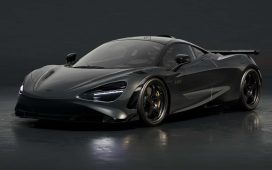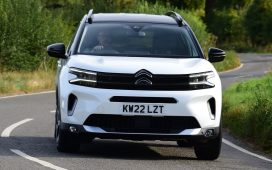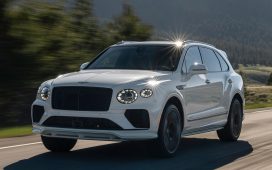2024 Ford Mustang GT | Cars.com photo by Leslie Cunningham
The verdict: The redesigned 2024 Ford Mustang GT gets a new tech-centric interior that’s designed to appeal to younger buyers, but the changes don’t dilute the sports car’s core driving characteristics; if anything, the GT’s updated V-8 engine is even burlier and louder than it was before.
Versus the competition: The Chevrolet Camaro and Dodge Challenger are soon exiting, leaving the Mustang without the traditional American-brand competition it’s had for more than a decade. When equipped with the available Performance Package, the four-seat Mustang GT offers much of the handling prowess of two-seaters like the Nissan Z and Toyota Supra, but the GT’s 5.0-liter V-8 gives it an entirely different character than those sports cars.
The Mustang is an enduring icon of the Ford brand — so enduring, in fact, that it’s seen competitors come, go, return and head for the exits once more in its nearly 60-year run. The Mustang has seen its share of changes over the years, but for the last few generations, the formula has largely been the same: two doors, rear-wheel drive, available V-8 power and a manual transmission for those who want one. The arrival of the Mustang Mach-E, an all-electric SUV with Mustang design cues, called that formula into question, but the Mach-E is so removed from the traditional Mustang sports car, it’s better to view it as a separate model.
Related: Which Trim Level of the 2024 Ford Mustang Should You Buy?
The 2024 Mustang should be arriving at Ford dealers by summer’s end, and we recently had the chance to drive EcoBoost and GT versions at the car’s media preview in Southern California. (Cars.com pays for its own lodging and airfare when attending such manufacturer-sponsored events.) This review covers both the GT coupe and convertible; if you want to know how the turbocharged four-cylinder in the EcoBoost performs, including what it’s like to use the Mustang’s new electronic drift brake, be sure to check out our Mustang EcoBoost quick spin.
Related Video:
How It Drives
The GT’s 5.0-liter V-8 gets a new air intake system that features twin air boxes and dual electronic throttle bodies, and the engine now makes 480 horsepower at 7,150 rpm (486 hp at 7,250 rpm when fitted with the available Active Valve Performance Exhaust) and 415 pounds-feet of torque at 4,900 rpm (418 pounds-feet with the active exhaust). That’s greater output than the 2023 Mustang Mach 1, and on the twisty canyon roads north of Los Angeles, it was an absolute treat to drive.
While the automatic-transmission-only EcoBoost four-cylinder is refined and makes the Mustang feel quick enough, the GT’s thumping V-8 transforms the car into a snarling beast — especially when fitted with the active exhaust system. I must be getting old because even the exhaust system’s Normal setting seems loud to me, and it has Sport and Track settings that are louder still. There’s also a quiet mode, and by the end of our driving day, that’s the one I wanted. Don’t get me wrong, the GT sounds great in a way that few modern cars do, but the rumbling exhaust note can get tedious after a while.
Both the coupe and convertible GTs I drove had the standard six-speed manual transmission (a 10-speed automatic is optional), and the V-8 and stick shift make a good pair. The six-speed manual has short throws, and there’s a mechanical precision to the shifter’s movements. The clutch pedal takes some effort to depress, but it’s not so heavy that you’ll have to worry about your left leg getting tired when slogging through stop-and-go traffic. The transmission also includes a rev-match feature that automatically blips the throttle when downshifting, but you can turn the feature off if you’d rather do it yourself. Other available performance features include launch control, line lock (for warming up the rear tires at a drag strip) and the electronic drift brake.
Both examples I drove had Ford’s MagneRide adaptive suspension, which is available on Premium models equipped with the Performance Package. The GT is a relatively comfortable highway cruiser with the MagneRide system; in the Normal drive mode, the ride is firm and you feel bumps and pavement breaks, but it doesn’t punish you or your passengers. Sport mode keeps body roll under control in fast corners, contributing to the GT’s fun feel.
Big Brembo brakes are part of the Performance Package or available as a stand-alone option. The brakes bite early when pressing the brake pedal, and they have no trouble shedding speed again and again when entering corners. They’re very strong, and they give you the confidence that you’ll be able to slow down as needed when hustling the Mustang quickly.
There are different settings (Normal, Comfort and Sport) for steering effort, but it’s hard to tell the difference between them in everyday driving; steering effort is light overall, which makes it easy to turn the wheel, but there’s not much steering feedback. More feedback and better differentiation between the steering settings would make the car’s performance even better.
Convertible Commentary
Convertible models have a lined and insulated fabric roof that keeps the interior fairly quiet at highway speeds. Breeziness is kept to a minimum in the front seats when the top is down, and the power top stows neatly behind the rear seats when lowered. The top doesn’t intrude on trunk space when down, and it operates quickly, taking around 10 seconds to motor back up into place. The windshield shimmies a bit on bumpier stretches of road, but it’s not excessive.
The Interior
The focal point of the 2024 Mustang’s cabin is its 12.4-inch digital instrument panel and 13.2-inch infotainment touchscreen, which are either separate displays or joined together by a curved glass panel depending on the model. We’ve seen the curved-panel design in other cars, and Ford hopes the tech-focused cabin will appeal to younger buyers.
Both the instrument panel and center touchscreen look great with bright, high-resolution graphics, and the center screen’s Sync 4 multimedia system is easy to navigate. You can customize the screen colors and ambient lighting through the interface; the gauge cluster appearance is also adjustable and includes a throwback design that mimics the analog gauges in Mustangs from the late ‘80s and early ‘90s. Wireless Apple CarPlay and Android Auto are supported, and it was easy to set up my iPhone with the system. Once paired, the CarPlay interface can use the full width of the center touchscreen, or you can leave the right-most quarter of the screen for supplemental vehicle information.
Most of the car’s climate controls now appear along the bottom of the center touchscreen as persistent icons. I found it fairly easy to adapt to not having separate physical air-conditioning controls, though I typically use the Auto setting and then just adjust cabin temperature as needed. Most audio controls are also incorporated into the screen, though Ford smartly retained a traditional volume knob below it, and there are also audio controls on the steering wheel.
The Premium coupe and convertible I drove had mostly good interior materials quality, with soft-touch surfaces on the doors and an upscale finish on the large center console. Combined with the large screens, it’s a nicely finished interior. The one thing that mars it, though, is the carbon-fiber-look plastic that’s sprinkled throughout the cabin: It looks cheap, and the interior would have been better served by something that actually looks like carbon fiber — or a different trim finish entirely.
The optional Recaro front bucket seats available with the Performance Package have much more substantial side bolsters than the car’s regular seats. They fit me snugly and kept me from moving side to side, but my passenger didn’t find them comfortable at all. The big bolsters also get in the way when driving; my upper arms were constantly bumping against them when steering through corners and shifting gears.
More From Cars.com:
Mustang GT in the Market
With the shift to electrification that’s happening across the car market, it wasn’t a foregone conclusion that we’d see a new Mustang GT powered by a big, loud V-8 engine — Dodge, for one, has already shown what an all-electric replacement for the Challenger could look like with its Charger Daytona SRT Concept. There are rumors that an all-electric Mustang sports car is coming in the future, but for now, Ford is giving Mustang shoppers the type of traditional performance they already know and love. If that’s what you want from a new sports car, the 2024 Mustang won’t disappoint.
Cars.com’s Editorial department is your source for automotive news and reviews. In line with Cars.com’s long-standing ethics policy, editors and reviewers don’t accept gifts or free trips from automakers. The Editorial department is independent of Cars.com’s advertising, sales and sponsored content departments.










